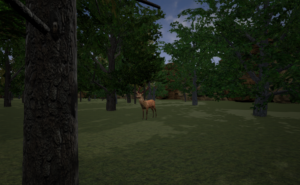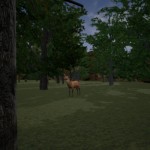We would like to invite you to the next research seminar of the Creative Technology Research Centre.
Title: Investigating and Visualising the Effects of Environment on Prey Detection Rates: A Key Variable in Human Evolution.
Time: 2:00PM-3:00PM
Date: Wednesday 22 April 2015
Room: P302 LT, Poole House, Talbot Campus
Abstract: This project utilises interactive 3D virtual worlds in order to determine the effect which the composition of the environment has on the ability of humans to detect prey animals within it.
The research focuses on the environments found in Europe prior to the Last Glacial Maximum, during the time period known as Oxygen Isotope Stage 3 (circa 30-55K years ago). By recreating various OIS3 environments virtually, we can investigate the effects of “openness” (degree of forestation), light levels, terrain and many other factors on prey detection rates.
Data is collected via experiments in which participants are able to navigate realistic 3D environments to search for prey animals. The search strategies they employ and the effect the environment is having on them can be recorded both from the software itself and via sophisticated eye-tracking technology. This data will inform us of the hunting strategies utilised by early human societies as they reacted to the changing landscape during OIS3.
This project makes use of Unreal Engine 4, a technology well suited to the creation of large, complex, interactive virtual worlds. UE4 is mostly associated with large-scale games development projects, but has the flexibility for use in this kind of research, often referred to as serious games.
We hope to see you there.

 Investigating the Effects of Environment on Prey Detection Rates: A Key Variable in Human Evolution
Investigating the Effects of Environment on Prey Detection Rates: A Key Variable in Human Evolution How prehistoric water pit stops may have driven human evolution
How prehistoric water pit stops may have driven human evolution










 Dr. Ashraf cited on ‘Modest Fashion’ in The Guardian
Dr. Ashraf cited on ‘Modest Fashion’ in The Guardian NIHR-funded research launches website
NIHR-funded research launches website Academics write for newspaper in Nepal
Academics write for newspaper in Nepal New paper published on disability in women & girls
New paper published on disability in women & girls Global Consortium for Public Health Research 2025
Global Consortium for Public Health Research 2025 MSCA Postdoctoral Fellowships 2025 Call
MSCA Postdoctoral Fellowships 2025 Call ERC Advanced Grant 2025 Webinar
ERC Advanced Grant 2025 Webinar Horizon Europe Work Programme 2025 Published
Horizon Europe Work Programme 2025 Published Horizon Europe 2025 Work Programme pre-Published
Horizon Europe 2025 Work Programme pre-Published Update on UKRO services
Update on UKRO services European research project exploring use of ‘virtual twins’ to better manage metabolic associated fatty liver disease
European research project exploring use of ‘virtual twins’ to better manage metabolic associated fatty liver disease